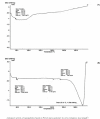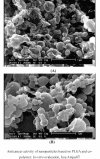Anticancer Activity of Nanoparticles Based on PLGA and its Co-polymer: In-vitro Evaluation
- PMID: 24523742
- PMCID: PMC3920687
Anticancer Activity of Nanoparticles Based on PLGA and its Co-polymer: In-vitro Evaluation
Abstract
Attempts have been made to prepare nanoparticles based on poly(lactic-co-glycolic acid) (PLGA) and doxorubicin. Biological evaluation and physio-chemical characterizations were performed to elucidate the effects of initial drug loading and polymer composition on nanoparticle properties and its antitumor activity. PLGA nanoparticles were formulated by sonication method. Lactide/glycolide ratio and doxorubicin amounts have been tailored. Fourier transform infrared spectroscopy (FTIR) and differential scanning calorimetry (DSC) were employed to identify the presence of doxorubicin within nanospheres. The in vitro release studies were performed to determine the initial ant net release rates over 24 h and 20 days, respectively. Furthermore, cytotoxicity assay was measured to evaluate therapeutic potency of doxorubicin-loaded nanoparticles. Spectroscopy and thermal results showed that doxorubicin was loaded into the particles successfully. It was observed that lactide/glycolide content of PLGA nanoparticles containing doxorubicin has more prominent role in tuning particle characteristics. Doxorubicin release profiles from PLGA 75 nanospheres demonstrated that the cumulative release rate increased slightly and higher initial burst was detected in comparison to PLGA 50 nanoparticles. MTT data revealed doxorubicin induced antitumor activity was enhanced by encapsulation process, and increasing drug loading and glycolide portion. The results led to the conclusion that by controlling the drug loading and the polymer hydrophilicity, we can adjust the drug targeting and blood clearance, which may play a more prominent role for application in chemotherapy.
Keywords: Antitumor activity; Doxorubicin; Nanoparticle; Poly(lactic-co-glycolic acid); Sustained release.
Figures











References
-
- Yadav A, Mishra P, Mishra A, Mishra P, Jain S, Agrawal G. Development and characterization of hyaluronic acid–anchored PLGA nanoparticulate carriers of doxorubicin. Nanomedicine Nanotech. Biol. Med. 2007;3:246–257. - PubMed
-
- American Cancer Society. Cancer Facts & Figures 2009. Atlanta: American Cancer Society; 2009. [19 January 2012]. Available from: URL: www.oralcancerfoundation.org/facts/pdf/Us_Cancer_Facts.pdf Accessed on 19 January 2012.
-
- Husseini G, Rapoport N, Christensen D, Pruitt J, Pitt W. Kinetics of ultrasonic release of doxorubicin from pluronic P105 micelles. Colloids Surf. B Biointer. 2002;24:253–264.
-
- Bromberg L, Alakhov V. Effects of polyether-modified poly(acrylic acid) microgels on doxorubicin transport in human intestinal epithelial Caco-2 cell layers. J. Control. Rel. 2003;88:11–22. - PubMed
LinkOut - more resources
Full Text Sources
